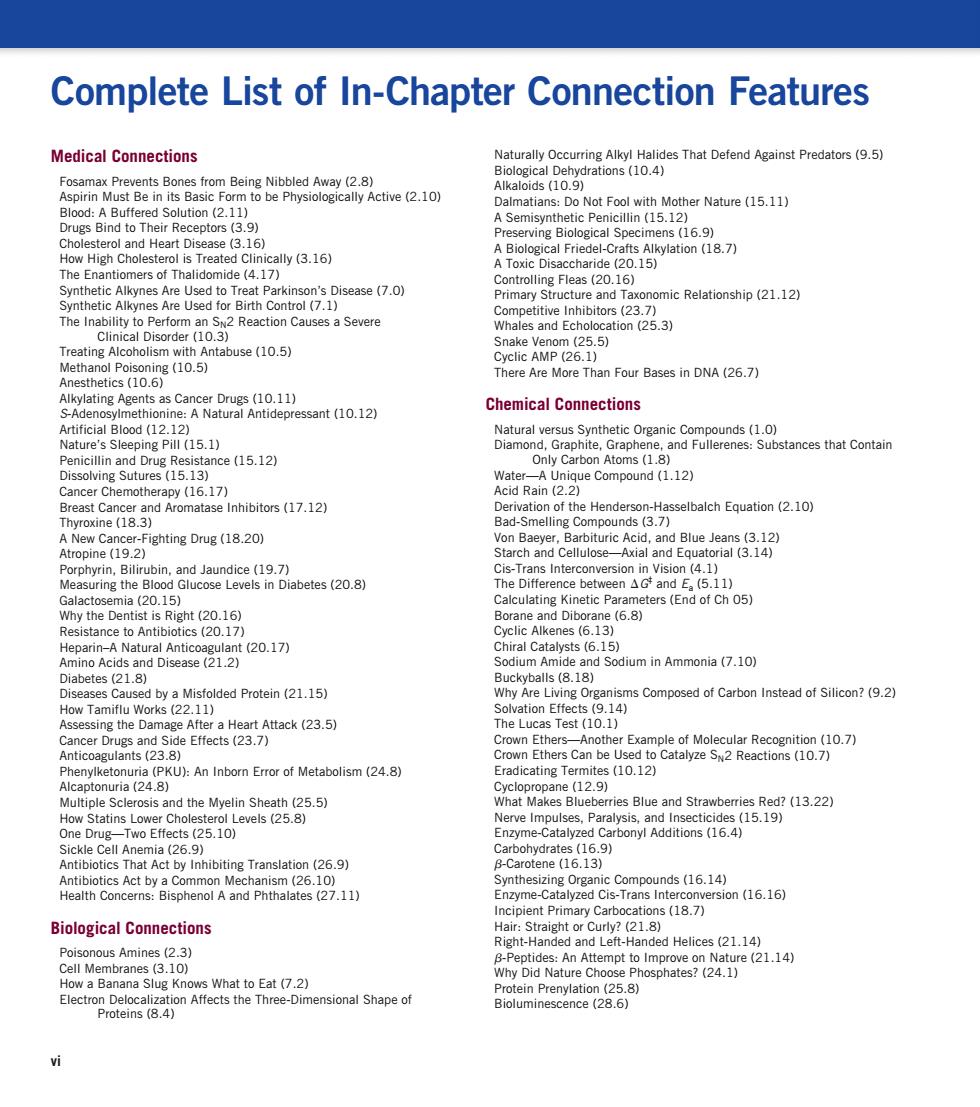正在加载图片...

Complete List of In-Chapter Connection Features Medical Connections Naturally Occurring Alkyl Halides That Defend Against Predators(9.5) Aieocl08gdratonsao.4y to be Physiologically Active(2.10) Dalmatians:Do Not Fool with Mother Nature (51 in (3) tic Penicillin (15.12 () 16Q e3. clinically (3.16) A Biol The Enantiomers of Thalidomide(4.17) A Toxic Dis 215 Alkynes Are Used Disease(7.0) omic Relationship(21.12) SN2 Reaction Causes a Severe Snake Venom (2.5) More Than Four Bases in DNA(26.7) Natura (1.12) Chemical Connections Natural ds (1 Nature's Sleeping Pill (15.1) Wate 0d1.12 Cancer Chemotherapy(16.17) Acid Rain(2.2) () (2.10) Cis-Trans Intere ersion in vision t 1 05 Borane and Diborane (6.8) Resistance to Antibiot (20.17 min (20.17 Sodium Amide and Sodium in Ammonia(710) Diabetes(21) a Misfolded Protein(21.15) s Composed of Carbon Instead of Silicon?(9.2) How Tamiflu Works(22.11) .) Test (10.1 n(10.7 Anticoagulants (23.8) 12.91 10.12 Multiple Sclerosis and the Myelin Sheath(25.5) (2510) evels (25.8) hydrates(16.9) Antibiotic 266.9 ic Compounds (16.14) alyzed ntp Gdcaiieg87esiona6.16) Biological Connections Hair:Straight orC y2(21.8 Right-Handed and Left-Handed Helices(21.14) e(21.14) ows What to Eat (7.2) on Affects the Three-Dimensional Shape of Protein Prenylatio 2868 i vi Medical Connections Fosamax Prevents Bones from Being Nibbled Away (2.8) Aspirin Must Be in its Basic Form to be Physiologically Active (2.10) Blood: A Buffered Solution (2.11) Drugs Bind to Their Receptors (3.9) Cholesterol and Heart Disease (3.16) How High Cholesterol is Treated Clinically (3.16) The Enantiomers of Thalidomide (4.17) Synthetic Alkynes Are Used to Treat Parkinson’s Disease (7.0) Synthetic Alkynes Are Used for Birth Control (7.1) The Inability to Perform an SN2 Reaction Causes a Severe Clinical Disorder (10.3) Treating Alcoholism with Antabuse (10.5) Methanol Poisoning (10.5) Anesthetics (10.6) Alkylating Agents as Cancer Drugs (10.11) S-Adenosylmethionine: A Natural Antidepressant (10.12) Artificial Blood (12.12) Nature’s Sleeping Pill (15.1) Penicillin and Drug Resistance (15.12) Dissolving Sutures (15.13) Cancer Chemotherapy (16.17) Breast Cancer and Aromatase Inhibitors (17.12) Thyroxine (18.3) A New Cancer-Fighting Drug (18.20) Atropine (19.2) Porphyrin, Bilirubin, and Jaundice (19.7) Measuring the Blood Glucose Levels in Diabetes (20.8) Galactosemia (20.15) Why the Dentist is Right (20.16) Resistance to Antibiotics (20.17) Heparin–A Natural Anticoagulant (20.17) Amino Acids and Disease (21.2) Diabetes (21.8) Diseases Caused by a Misfolded Protein (21.15) How Tamiflu Works (22.11) Assessing the Damage After a Heart Attack (23.5) Cancer Drugs and Side Effects (23.7) Anticoagulants (23.8) Phenylketonuria (PKU): An Inborn Error of Metabolism (24.8) Alcaptonuria (24.8) Multiple Sclerosis and the Myelin Sheath (25.5) How Statins Lower Cholesterol Levels (25.8) One Drug—Two Effects (25.10) Sickle Cell Anemia (26.9) Antibiotics That Act by Inhibiting Translation (26.9) Antibiotics Act by a Common Mechanism (26.10) Health Concerns: Bisphenol A and Phthalates (27.11) Biological Connections Poisonous Amines (2.3) Cell Membranes (3.10) How a Banana Slug Knows What to Eat (7.2) Electron Delocalization Affects the Three-Dimensional Shape of Proteins (8.4) Naturally Occurring Alkyl Halides That Defend Against Predators (9.5) Biological Dehydrations (10.4) Alkaloids (10.9) Dalmatians: Do Not Fool with Mother Nature (15.11) A Semisynthetic Penicillin (15.12) Preserving Biological Specimens (16.9) A Biological Friedel-Crafts Alkylation (18.7) A Toxic Disaccharide (20.15) Controlling Fleas (20.16) Primary Structure and Taxonomic Relationship (21.12) Competitive Inhibitors (23.7) Whales and Echolocation (25.3) Snake Venom (25.5) Cyclic AMP (26.1) There Are More Than Four Bases in DNA (26.7) Chemical Connections Natural versus Synthetic Organic Compounds (1.0) Diamond, Graphite, Graphene, and Fullerenes: Substances that Contain Only Carbon Atoms (1.8) Water—A Unique Compound (1.12) Acid Rain (2.2) Derivation of the Henderson-Hasselbalch Equation (2.10) Bad-Smelling Compounds (3.7) Von Baeyer, Barbituric Acid, and Blue Jeans (3.12) Starch and Cellulose—Axial and Equatorial (3.14) Cis-Trans Interconversion in Vision (4.1) The Difference between ∆G‡ and Ea (5.11) Calculating Kinetic Parameters (End of Ch 05) Borane and Diborane (6.8) Cyclic Alkenes (6.13) Chiral Catalysts (6.15) Sodium Amide and Sodium in Ammonia (7.10) Buckyballs (8.18) Why Are Living Organisms Composed of Carbon Instead of Silicon? (9.2) Solvation Effects (9.14) The Lucas Test (10.1) Crown Ethers—Another Example of Molecular Recognition (10.7) Crown Ethers Can be Used to Catalyze SN2 Reactions (10.7) Eradicating Termites (10.12) Cyclopropane (12.9) What Makes Blueberries Blue and Strawberries Red? (13.22) Nerve Impulses, Paralysis, and Insecticides (15.19) Enzyme-Catalyzed Carbonyl Additions (16.4) Carbohydrates (16.9) b-Carotene (16.13) Synthesizing Organic Compounds (16.14) Enzyme-Catalyzed Cis-Trans Interconversion (16.16) Incipient Primary Carbocations (18.7) Hair: Straight or Curly? (21.8) Right-Handed and Left-Handed Helices (21.14) b-Peptides: An Attempt to Improve on Nature (21.14) Why Did Nature Choose Phosphates? (24.1) Protein Prenylation (25.8) Bioluminescence (28.6) Complete List of In-Chapter Connection Features